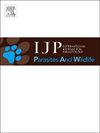First report of three different parasite species in two dolphin species stranded on the coast of Portugal
IF 2
3区 医学
Q3 ECOLOGY
International Journal for Parasitology-Parasites and Wildlife
Pub Date : 2025-06-16
DOI:10.1016/j.ijppaw.2025.101102
引用次数: 0
Abstract
Understanding the dynamics of the interaction of marine parasites with their hosts, especially in terms of diversity, distribution and pathogenicity can be of great importance in a Global Change era. Monitoring the parasite diversity of marine mammals holds not only ecological importance but also can be of significance for public health. However, there is a scarcity of parasitological research on cetaceans in the eastern Atlantic Ocean, namely in Portugal. Here we explore the morphology, diversity and pathogenicity of parasites in two different cetaceans, Delphinus delphis (common dolphin) and Stenella coeruleoalba (striped dolphin), stranded near the coast of Lisbon, Portugal. During their necropsy, three parasite species were collected and preserved in 70 % ethanol. In the laboratory, nematodes were identified as Halocercus delphini, and tetraphyllidean merocercoids as Clistobothrium delphini and Clistobothrium grimaldii. Additionally, C. delphini specimens were classified as belonging to morphotypes B and C. To the authors' knowledge, this is the first reference of these three parasites species in Portugal. This information is critical for understanding the impact of these organisms on the health of dolphins and adds information to the parasitological fauna of these hosts.
首次报道在葡萄牙海岸搁浅的两种海豚体内发现三种不同的寄生虫
了解海洋寄生虫与宿主相互作用的动态,特别是在多样性、分布和致病性方面,在全球变化时代具有重要意义。监测海洋哺乳动物的寄生虫多样性不仅具有生态重要性,而且对公共卫生也具有重要意义。然而,在东大西洋,即葡萄牙,对鲸类动物的寄生虫学研究缺乏。本文研究了搁浅在葡萄牙里斯本海岸附近的两种不同的鲸类动物Delphinus delphis(普通海豚)和Stenella coeruleoalba(条纹海豚)体内寄生虫的形态、多样性和致病性。在尸体解剖过程中,收集了三种寄生虫并保存在70%的乙醇中。在实验室中,线虫鉴定为delphini Halocercus,四酰基双头小球虫鉴定为delphini Clistobothrium和grimaldii Clistobothrium。此外,该寄生虫标本被划分为B型和c型。据作者所知,这是这三种寄生虫在葡萄牙的首次参考资料。这些信息对于了解这些生物对海豚健康的影响至关重要,并为这些宿主的寄生动物群提供了信息。
本文章由计算机程序翻译,如有差异,请以英文原文为准。
求助全文
约1分钟内获得全文
求助全文
来源期刊

International Journal for Parasitology-Parasites and Wildlife
Medicine-Infectious Diseases
CiteScore
3.80
自引率
5.60%
发文量
113
审稿时长
45 days
期刊介绍:
The International Journal for Parasitology: Parasites and Wildlife (IJP-PAW) publishes the results of original research on parasites of all wildlife, invertebrate and vertebrate. This includes free-ranging, wild populations, as well as captive wildlife, semi-domesticated species (e.g. reindeer) and farmed populations of recently domesticated or wild-captured species (e.g. cultured fishes). Articles on all aspects of wildlife parasitology are welcomed including taxonomy, biodiversity and distribution, ecology and epidemiology, population biology and host-parasite relationships. The impact of parasites on the health and conservation of wildlife is seen as an important area covered by the journal especially the potential role of environmental factors, for example climate. Also important to the journal is ''one health'' and the nature of interactions between wildlife, people and domestic animals, including disease emergence and zoonoses.
 求助内容:
求助内容: 应助结果提醒方式:
应助结果提醒方式:


